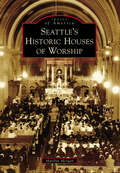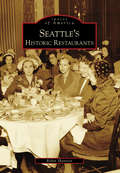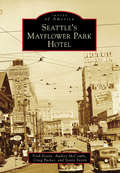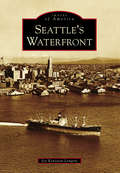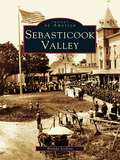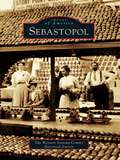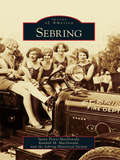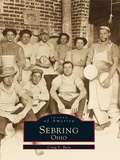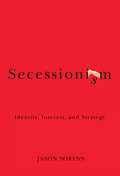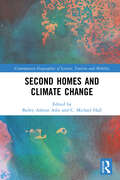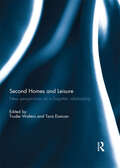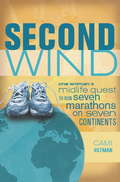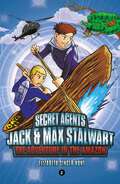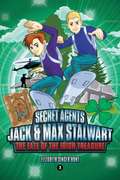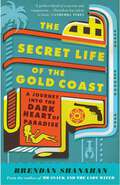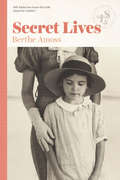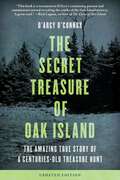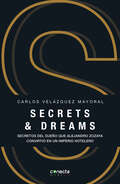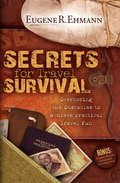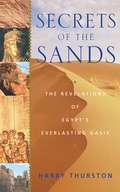- Table View
- List View
Seattle's Historic Hotels (Images of America)
by Robin ShannonMary Ann Conklin, also known as "Madame Damnable," ran Seattle's first hotel, the Felker House, which burned to the ground in the Great Seattle Fire of 1889. The Rainier Hotel was erected quickly following the Great Seattle Fire but razed around 1910. The Denny Hotel, an architectural masterpiece later known as the Washington Hotel, was built in 1890 but torn down in 1907 during the massive regrade that flattened Denny Hill. Upon opening in 1909, the Sorrento Hotel was declared a "credit to Seattle" by the Seattle Times. The Olympic Hotel was the place for Seattle's high society throughout the 1920s. The Hotel Kalmar was a workingman's hotel built in 1881 and was razed for the Seattle tollway. The Lincoln Hotel was destroyed by a tragic fire in 1920, along with its rooftop gardens. The famous and grand Seattle Hotel in Pioneer Square was replaced by a "sinking ship" parking garage, thus sparking preservationists to band together to establish Pioneer Square as a historic district.
Seattle's Historic Houses of Worship (Images of America)
by Marilyn MorganAs Seattle grew in the mid-1800s, the increase in families settling in the area created a need for churches. Seattle First Church was established in 1853 and by 1901 Seattle had 112 churches; today, there are less than 20 of these churches still in existence. Seattle’s Historic Houses of Worship explores many of these churches, examining how they have survived over 100 years, while still going strong today. Churches have guided the Seattle community through the great Seattle fire, world wars, internment camps, the assassination of a president, and the protests of the civil rights era.
Seattle's Historic Restaurants
by Robin ShannonSeattle's Historic Restaurants depicts an era of nostalgia and romanticism, and highlights historic photographs of restaurants, postcards, and menus. From 1897 to 1898, thousands of so-called stampeders came through Seattle on their way to the Klondike goldfields. Hungry stampeders could purchase a meal at the Merchant's Café (the oldest café in Seattle) or one of the many restaurants nearby. For the next 25 years, those who made it rich in Seattle were the restaurateurs, shop owners, and real estate owners. Famous local landmarks such as the Space Needle, Mount Rainier's Paradise Camp, Snoqualmie Falls, and the Empress Hotel are still here, but their menus and clientele have changed over the years. Local haunts like Ivar's Acres of Clams, The Dog House, Andy's Diner, Clark's Restaurants, Coon Chicken Inn, Frederick and Nelson's Tea Room, The Wharf, Von's, The Purple Pup, and the Jolly Roger are just a few of the restaurants featured within.
Seattle's Mayflower Park Hotel (Images of America)
by Craig Packer Stevie Festin Audrey Mccombs Trish FestinThe Mayflower Park Hotel started life as the Bergonian Hotel on July 16, 1927. One of Seattle's first uptown hotels, it was designed by architect B. Dudley Stuart and built by Stephen Berg at a cost of $750,000. In the midst of the Great Depression, the hotel was sold and renamed Hotel Mayflower. In 1948, Washington State legalized cocktail lounges, and the Hotel Mayflower became Seattle's first hotel to open one. In the ensuing decades, Seattle prospered, and it hosted the 1962 World's Fair with its symbolic Space Needle. By the 1970s, Seattle was in a deep recession, and the hotel had become sadly neglected. In 1974, Birney and Marie Dempcy formed a limited partnership to purchase the hotel and renamed it the Mayflower Park Hotel. Restoration started immediately, and after 40 years, the Dempcys remain dedicated to the tradition of making the Mayflower Park Hotel "Quite Simply, One of a Kind."
Seattle's Waterfront
by Joy Keniston-LongrieSeattle's waterfront has served as a central hub for people, transportation, and commerce since time immemorial. A low natural shoreline provided the Duwamish-Suquamish people with excellent canoe access to permanent villages and seasonal fishing camps. High bluffs served as a sacred place for tribal members' final journey to the spirit world. When the first settlers arrived in the 1850s, Seattle's shoreline began to change drastically. Emerald hills covered with dense forests were logged for timber to make way for the new city. As time passed, Seattle constructed a log seawall, wooden sidewalks, wharfs, buildings, streets, railroad trestles, and eventually, a massive concrete viaduct over the original aquatic lands, changing the natural environment to a built environment. Today, Seattle's shoreline continues to change as the city demolishes the viaduct, rebuilds the seawall, and creates an inviting new waterfront that all will enjoy for generations to come.
Sebasticook Valley (Images of America)
by Brenda SeekinsSebasticook Valley, located between the east and west branches of the Sebasticook River in central Maine, consists of several communities. This book showcases the six towns at the valley's center: Hartland, St. Albans, Newport, Pittsfield, Palmyra, and Detroit. The communities share many ties, including the river itself; farming, manufacturing, and families; multiple railroad lines; lakes and ponds that attract summer visitors and sportsmen for hunting and fishing; and religious and military encampments and reunions. Located at the "crossroads of Maine," the valley is familiar to travelers through central Maine or to the northern counties and Canada. The rise and fall of the Sebasticook River over a century has influenced the region's history and landscape, fortifying the Yankee independence and spirit of area residents.
Sebastopol
by The Western Sonoma County Historical SocietySince the 1850s, the soothing countryside hamlets of Sonoma County have beckoned settlers of every stripe-farmers, homesteaders, businesspeople, and commuters. Sebastopol has always been among the county's loveliest towns, retaining its small-town feel even as its population has steadily grown. This book of vintage photography presents Sebastopol's journey through time, the early Mexican land grants and initial settlements, Luther Burbank's far-ranging botanical experiments, and the rich farming industry that made this town one of California's premier agricultural zones, producing grapes, hops, cherries, and dairy products. In these pages readers will experience Sebastopol's turn-of-the-century days at the Apple Fair, with its astonishing fruit sculptures. The first days of railroads are illustrated with images of the Petaluma & Santa Rosa Railway, an electric train system that took passengers to and from Sebastopol Depot. The architecture of the region and the stories of local businesses and institutions are all shown here, along with Sebastopol's early religious institutions, schools, sawmills, factories, and even its small airport in the 1920s. Together with views of the town's sporting teams, natural history, outlying communities, and important citizens, these photographs tell a unique story of a unique place that transcends the generations.
Sebring
by Randall M. Macdonald Sebring Historical Association Susan Priest MacdonaldIn 1911, Ohio entrepreneur George E. Sebring was drawn to the raw south-central Florida peninsular wilderness, known for bountiful fishing and game. After cofounding Sebring, Ohio, in 1898, he envisaged another eponymous town that would attract new residents to this largely unsettled area located 30 miles from the nearest railroad depot. The businessman purchased 9,000 acres on the shore of Lake Jackson, and his new town was designed and surveyed between October 1911 and April 1912. By virtue of its location along the Atlantic Coast Line Railroad, the community of Sebring emerged as a novel tourist and golfing destination and was established as the seat of newly formed Highlands County in 1921. Cultural and technological advances have transformed the once-rural community into a thriving modern city that today retains its small-town atmosphere as the City on the Circle.
Sebring, Ohio
by Craig S. BaraThe Sebring family came from the Netherlands and moved to Pennsylvania. George E. and Elizabeth Larkins Sebring eventually settled in East Liverpool, where they ran a grocery business and lived with their ten children. The Sebrings then decided to find property and build a pottery town, as they had been involved in potteries in East Liverpool and East Palestine. They settled on 200 acres of farmland near the Mahoning River, with the railroad running through the property. After a great deal of work in starting the new town, the Articles of Incorporation were filed in 1899. Potteries and homes were constructed, and Sebring became a flourishing town, at one point considered the pottery center of the world.
Secessionism: Identity, Interest, and Strategy
by Jason SorensUsing innovative methods to analyze both advanced democracies and developing countries, Jason Sorens shows how central governments can alleviate or increase ethnic minority demands for regional autonomy. He argues that when countries treat secession as negotiable and provide legal paths to pursuing it rather than absolutely prohibiting independence, violence is far less likely. Additionally, independence movements encourage government policies of decentralization that may be beneficial to regional minorities. An informative investigation of the root causes of political violence, Secessionism provides a clear-eyed look at independence movements for both governments and secessionists.
Second Homes and Climate Change (Contemporary Geographies of Leisure, Tourism and Mobility)
by C. Michael Hall Bailey Ashton AdieThis book is the first to address the important interrelationship between second homes and climate change, which has become an increasingly relevant issue for many regions around the world. Second homes are often a key source of tourist visitation as well as economic benefit for their host communities. The chapters provide an array of international case studies and climate change impacts, including the changing biocultural landscapes in Italy, hazard risks in the mountains of Poland, and the shifting media discussion on second homes and climate change in Finland. Topics covered focus on issues around planning and governance in second home locations, adaptation and mitigation measures implemented by second home owners, and the influence of second home owners’ place attachment in relation to second home impacts. It introduces the overall topic of second homes and climate change while also laying the groundwork for future work in this burgeoning area of research. This book will be of significant interest to upper-level undergraduates, graduate students, and academics in the fields of geography, tourism, planning, housing studies, regional development, environmental management, and disaster management. It would also be of use for professionals who engage with second home communities, particularly planners, government officials, and environmental officers.
Second Homes and Climate Change (Contemporary Geographies of Leisure, Tourism and Mobility)
by C. Michael Hall Bailey Ashton AdieThis book is the first to address the important interrelationship between second homes and climate change, which has become an increasingly relevant issue for many regions around the world. Second homes are often a key source of tourist visitation as well as economic benefit for their host communities. The chapters provide an array of international case studies and climate change impacts, including the changing biocultural landscapes in Italy, hazard risks in the mountains of Poland, and the shifting media discussion on second homes and climate change in Finland. Topics covered focus on issues around planning and governance in second home locations, adaptation and mitigation measures implemented by second home owners, and the influence of second home owners’ place attachment in relation to second home impacts. It introduces the overall topic of second homes and climate change while also laying the groundwork for future work in this burgeoning area of research. This book will be of significant interest to upper-level undergraduates, graduate students, and academics in the fields of geography, tourism, planning, housing studies, regional development, environmental management, and disaster management. It would also be of use for professionals who engage with second home communities, particularly planners, government officials, and environmental officers.
Second Homes and Leisure: New perspectives on a forgotten relationship
by Trudie Walters and Tara DuncanSecond homes (variously summer houses, shacks, baches, cottages, dacha) are a popular cultural phenomenon in many countries and an emerging trend in others. They are inextricably linked to tourism, recreation and leisure, and yet the fundamental relationship between second homes and leisure often appears to have been overlooked by researchers in the area. This book seeks to address this absence, bringing together an exciting collection of research from around the world. Drawing on examples from Canada, Japan, Morocco, Costa Rica, New Zealand and the United Kingdom, this book highlights the interdisciplinary nature of second home research in the leisure field. The book describes the nexus of second homes and leisure from a variety of perspectives: planning and policy, historical, social and cultural. It is an essential work for those interested in new cultural viewpoints on second homes and leisure practices. This book was originally published as a special issue of Annals of Leisure Research.
Second Wind: One Woman's Midlife Quest to Run Seven Marathons on Seven Continents
by Cami OstmanSecond Wind is the story of an unlikely athlete and an unlikely heroine: Cami Ostman, a woman edging toward midlife who decides to take on a challenge that stretches her way outside of her comfort zone. That challenge presents itself when an old friend suggests she go for a run to distract her from the grief of her recent divorce. Excited by the clarity of mind and breathing space running offers her, she keeps it up - albeit slowly - and she decides to run seven marathons on seven continents; this becomes Ostman's vision quest, the thing she turns to during the ups and downs of a new romance and during the hard months and years of redefining herself in the aftermath of the very restrictive, religious-based marriage and life she led up until her divorce. Insightful and uplifting, Second Wind carries the reader along for the ride as Ostman runs her way out of compliance with the patriarchal rules about "being a woman" that long held her captive and into authenticity and self-love. Her adventures - and the personal revelations that accompany them - inspire readers to take chances, find truth in their lives, and learn to listen to the voice inside them that's been there all along.
Secret Agents Jack and Max Stalwart: Brazil (The Secret Agents Jack and Max Stalwart Series #2)
by Elizabeth Singer HuntFor fans of the award-winning SECRET AGENT JACK STALWART series comes a must-read new chapter book series! Now Jack teams up with his older brother, Max, to solve new international mysteries, using their special training as secret agents. Secret agents Jack and Max Stalwart are sent to the Amazon jungle to investigate the disappearance of an important Global Protection Force scientist. Soon, they discover that the scientist's disappearance is no accident. A greedy outlaw is illegally mining for gold and he'll stop and nothing to keep his secret safe. Can Jack and Max save themselves and the scientist from almost certain death?
Secret Agents Jack and Max Stalwart: The Fate of the Irish Treasure: Ireland (Secret Agents Jack and Max Stalwart Series #3)
by Elizabeth Singer Hunt Brian WilliamsonThe third jet-setting installment in the thrilling award-winning chapter book series Secret Agents Jack and Max Stalwart, by Elizabeth Singer Hunt (Secret Agent Jack Stalwart). <P><P>Now Jack teams up with his older brother Max to solve an intriguing Irish mystery, using their special training as secret agents. Ireland's greatest national treasure, the sacred Book of Kells, vanishes from a library in Dublin. Clues point to the Mastermind being involved. Will Jack and Max be able to find the Book and uncover the Mastermind's identity before he strikes again?
Secret Life of the Gold Coast: A Journey into the Dark Heart of Paradise
by Brendan ShanahanThe Gold Coast: City of the Future; metropolis of dreams. In less than fifty years a tiny holiday town of fibro shacks and mangrove swamps has grown to become a city of almost a million people and an embodiment of our unquenchable lust for surf, sun and sand. Set against a backdrop of marina developments for the near-dead, a rampant drug culture, the underground porn industry and the anarchy of schoolies week, The Secret Life of the Gold Coast is a disturbing but often comical expose that trawls the underbelly of Gold Coast life while pondering the elusive nature of Paradise and the unexpected consequences of our desires.
Secret Lives
by Berthe AmossSet in 1930's New Orleans, twelve-year-old Addie Agnew struggles to uncover the mystery of her mother's death. Living with her spinster aunts, Addie was told her mother was perfect and she was swept out to sea in a tidal wave. In this classic story about family secrets and growing up, Addie will stop at nothing to discover the truth.
Secret Places, Hidden Sanctuaries: Uncovering Mysterious Sights, Symbols, and Societies
by Gerald Warner Stephen Klimczuk“[A] brilliant new tome . . . If you like intrigue, hidden gems and historical treatments about all things ‘off limits’ this book will fascinate you.” —The American SpectatorThe doors of some of the world’s best-hidden places and most secretive organizations have now been thrown wide open! Some of the names are familiar: Area 51, Yale’s Skull and Bones, Opus Dei, the Esalen Institute. Others are more obscure, hidden by fate or purposeful deception, such as the Mount Weather Emergency Operations Center, the super-secure facility where Vice President Dick Cheney was secreted after the 9/11 attacks, and Germany’s Wewelsburg Castle, which was intended to become the mythological centerpiece of the Nazi Regime. Readers can take an unprecedented look deep inside the off-the-map military installations and shadowy organizations that operate in the murkiest corners of our world.“A great book . . . written with wit and style . . . Of course there are many other famous sites discussed as well, from the brooding castle which Himmler designed as the headquarters of the SS, to the shrine of the Oracle at Delphi, to Bollengin Tower on Lake Zurich, Switzerland, which Carl Jung built as a retreat for his study into psychology.” —The Scottish Rite of Freemasonry
Secret Seattle: An Illustrated Guide to the City's Offbeat and Overlooked History (Seattle Walk Report)
by Susanna RyanCapturing the same charm and whimsy she brought to Seattle Walk Report, Instagram darling Susanna Ryan takes things a step further, revealing the forgotten history behind the people, places, and things that shaped Seattle.Cartoonist and creator of Seattle Walk Report, Susanna Ryan strolls on with a quirky new illustrated guide celebrating Seattle's historical treasures and outdoor wonders. In Secret Seattle, Ryan explores the weird and wonderful hidden history behind some of the city's most overlooked places, architecture, and infrastructure, from coal chutes in Capitol Hill, to the last remainder of Seattle's original Chinatown in Pioneer Square, to the best places in town to find century-old sidewalks. Discover pocket parks, beautiful boulevards, and great public gardens while learning offbeat facts that will make you see the Emerald City in a whole new way. Perfect for both the local history buff who never leaves a favorite armchair to a walking enthusiast looking for offbeat and off-the-beaten-path scavenger hunts.
Secret Treasure of Oak Island: The Amazing True Story of a Centuries-Old Treasure Hunt
by D'Arcy O'ConnorIt started on a summer afternoon in 1795 when a young man named Daniel McGinnis found what appeared to be an old site on an island off the Acadian coast, a coastline fabled for the skullduggery of pirates. The notorious Captain Kidd was rumored to have left part of his treasure somewhere along here, and as McGinnis and two friends started to dig, they found what turned out to be an elaborately engineered shaft constructed of oak logs, nonindigenous coconut mats, and landfill that came to be known as the Money Pit.Ever since that summer day in 1795, the possibility of what might be hidden in the depths of a small island off the south coast of Nova Scotia, Canada, has made it the site of the world's longest, most expensive, and most perplexing treasure hunt. Author D'Arcy O'Connor recounts the fascinating stories and amazing discoveries of past and current treasure seekers who have sought Oak Island's fabled treasure for over two hundred years. It has baffled scientists and madmen, scholars and idiots, millionaires and get-rich-quick schemers, psychics, engineers, charlatans, and even a former president of the United States. The island has consumed the fortunes-and in some cases, the lives-of those who have obsessively set out to unlock its secret. Despite all their efforts, the mystery remains unsolved, and not a single dime of treasure has ever been recovered.The present-day search is an archaeological dig exceeding anything ever done anywhere for similar purposes, and it may well result in the discovery of one of the world's richest and most historically significant treasures. But this is also the story of individuals who have dedicated years of their lives to discover what was buried long ago beneath this strange island. They are driven by a lust for gold, by archaeological curiosity, and by their determination to outwit the engineer who was responsible for the Oak Island enigma.
Secrets & dreams: Secretos del sueño que Alejandro Zozaya convirtió en un imperio hotelero
by Carlos Velázquez MayoralSi usas zapatos grandes, te crecen los pies. Secrets & Dreams es la historia de Alejandro Zozaya, el mexicano que construyó un imperio hotelero y salvó el turismo nacional en más de una ocasión, escrita a partir de las entrevistas que tuvo con el reconocido periodista especializado en negocios y turismo, Carlos Velázquez Mayoral. 2.7 mil millones de dólares fue la oferta que Hyatt hizo a Zozaya para comprar Apple Leisure Group, el consorcio hotelero que más estadounidenses atrae a México, cuyo éxito recae en la operadora AMResorts y marcas como Secrets y Dreams, bajo el modelo todo incluido de lujo, particularmente efectivo en las crisis y que se ha implementado en destinos de playa en México, el Caribe, Centroamérica y España. Su trayectoria comenzó cuando su familia perdió su casa a causa del terremoto de 1985 y se convirtió en una oportunidad económica durante un viaje de mochilero, cuando descubrió su pasión por la hotelería y los restaurantes, carrera que empezaría de cero en Grupo Posadas, lavando platos y limpiando cuartos en los hoteles que años más tarde terminaría dirigiendo. Alejandro entendió el poder de crear y dirigir la demanda, de desarrollar una plataforma estratégica de negocios y de influir en la economía. De ahí que haya jugado roles protagónicos en las últimas crisis del sector, incluyendo las pandemias por influenza AH1N1 y por covid-19, no sólo como líder de opinión, sino proponiendo estrategias de recuperación y fomentando la colaboración entre los empresarios del sector. En este libro, Alejandro, a través de la pluma de Carlos Velázquez, compartirá estos y otros aprendizajes que sin duda resultarán útiles para los jóvenes emprendedores
Secrets & dreams: The secrets behind Alejandro Zozaya´s hotel empire, wich began as a dream
by Carlos Velázquez MayoralIF YOU WEAR BIG SHOES, YOUR FEET WILL GROW. Secrets & Dreams tells the story of Alejandro Zozaya, a Mexican hotelier that built an empire and saved Mexico’s tourism industry more than once. Carlos Velázquez Mayoral, renowned business and travel journalist, sat down with this amazing businessman, who shared his life story through in-depth interviews. Hyatt offered Zozaya 2.7 billion dollars to acquire Apple Leisure Group, the most visited hotel chain by Americans in Mexico, whose success lies in its operator, AMResorts, and brands such as Secrets and Dreams. Its luxury all-inclusive business model has proven to be resilient during crises and has been implemented in important beach destinations in Mexico, the Caribbean, Central America, and Spain. Alejandro’s story, however, started when his family lost their house in the 1985 earthquake that devasted Mexico City. This caused him to turn a backpacking trip across Europe into an economic opportunity: He started working at Grupo Posadas, where he discovered his passion for the restaurant and hotel industry and worked his way up from dishwasher and housekeeper to top executive. Alejandro understood the power of creating and managing demand, developing a strategic business platform, and influencing the economy. This has propelled him as a key player and opinion leader during the last crises that have affected the industry, including the AH1N1 flu and COVID-19 pandemics, proposing recovery strategies and encouraging collaboration between business owners. In this book, Carlos Velázquez writing brings to life Alejandro’s knowledge and insights, useful to young entrepreneurs everywhere.
Secrets for Travel Survival: Overcoming the Obstacles to Achieve Practical Travel Fun
by Eugene R. EhmannLeave the stress and anxiety behind, and learn to enjoy traveling again with these expert tips. Travel can be an adventure, but it can also be overwhelming. Written by an experienced world traveler who also entertainingly recounts his own journeys, this guide can help you feel relaxed and ready to go, whether you&’re on the road for business or pleasure. Learn: * How to prepare for your trip to ensure the results you want * How to plan your trip for the smoothest outcome * How to best move through airport security * How to visit or work in foreign countries where you know little or no local language * How to be and feel safe and secure . . . and still have fun!
Secrets of the Sands: The Revelations of Egypt
by Harry ThurstonIn a part of Egypt so parched that decades might pass between rainstorms, amid a sea of sand, is a green island--Dakhleh, the "everlasting oasis"--that may contain the whole of human history. In this extraordinary book, an acclaimed science writer and journalist follows an international team of archaeologists as they unlock the secrets of nearly half a million years. Using high-tech methods, these scientists have made stunning finds, including indications that Dakhleh may have been the cradle of the Nile civilization that gave rise to the pharaohs and the pyramids.They have unearthed a perfect Old Kingdom town, with palaces and temples from the Golden Age, huge caches of mummies and papyri, and the world's two oldest books, and have located an entire Roman city--a Pompeii in the middle of the desert. Blending elements of adventure narrative, travelogue, and scientific mystery, Secrets of the Sands also traces on a grand historical scale the story of how humans have interacted with the changing environment, laying bare a parable with relevance to us all about the fragile balance between humankind and our world.

